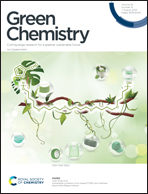1,2,3-Trimethoxypropane: a bio-sourced glyme as electrolyte for lithium–O2 batteries†
Abstract
Li–O2 batteries are actively being investigated due to their high theoretical energy density (∼11 000 Wh kg−1), which would compete with gasoline energy per Kg in electric vehicles. Linear glymes are the most appealing electrolytes for Li–O2 batteries due to their large electrochemical window, stability against radicals and solubility of Li+ metal ions. However, all these superior properties are tarnished by their high toxicity. Herein, a greener glyme derived from bio-sourced glycerol (1,2,3-trimethoxypropane (TMP)), is proposed for the first time as a solvent in an electrolyte for Li–O2 batteries. TMP performance has been compared to its toxic linear isomer, diglyme, and most popular tetraglyme as a liquid electrolyte and gel polymer electrolyte (GPE) membranes. GPEs were based on a mix of mono-, di- and tri- functional acrylates, cured simultaneously within a liquid electrolyte mix (1 M LiTFSI in the plasticizers) by UV-photopolymerisation. GPE-TMP based membranes showed a high ionic conductivity (2.33 × 10−3 S cm−1 at 25 °C), directly comparable to the other glymes. Moreover, this remarkable conductivity was very close to the liquid TMP-based electrolyte (3.59 × 10−3 S cm−1 at 25 °C). When used as electrolytes in lithium symmetrical cells, the GPE-TMP electrolyte enhanced the polarisation when compared to the liquid TMP-based cells, especially at higher rates (<0.6 V observed at ±1 mA cm−2). Performance in Li–O2 cells showed that GPE-TMP electrolytes achieved a discharge capacity as high as 2.75 mA h cm−2 (3819 mA h g−1), ahead of GPE-diglyme or GPE-tetraglyme electrolytes (2.34 and 2.09 mA h cm−2, respectively). When cycled, cells using TMP-based electrolyte had a similar capacity retention than the ones with tetraglyme, confirming the potential use of TMP as solvent/plasticizer in electrolytes for Li–O2 cells.



 Please wait while we load your content...
Please wait while we load your content...